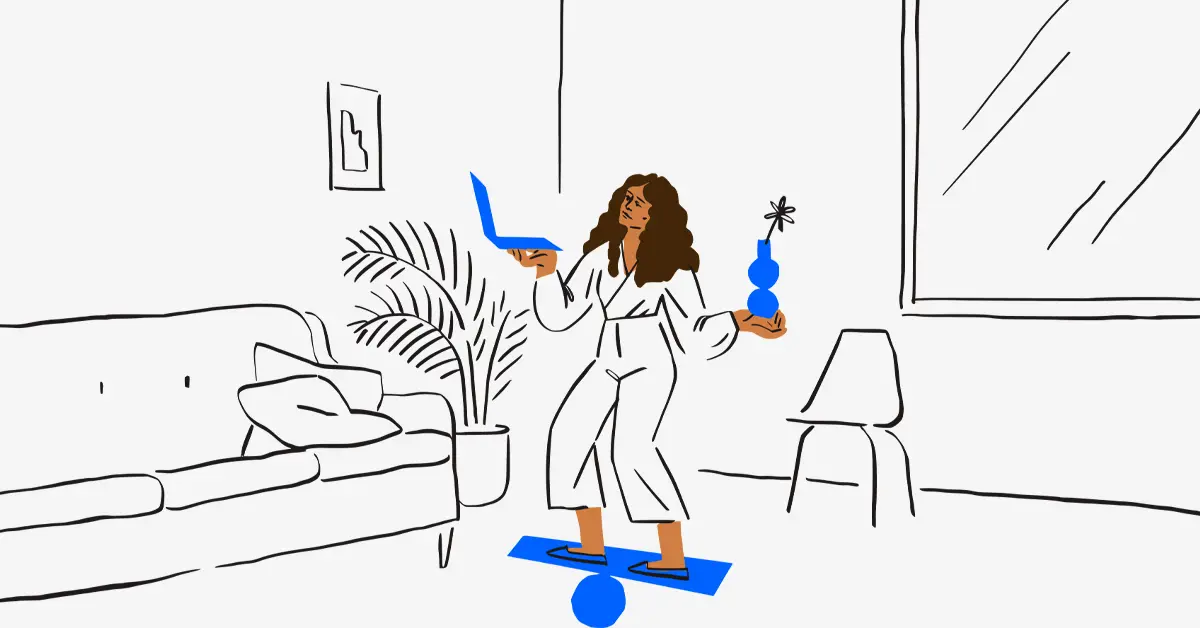
Last week, our team got together in person and it was glorious. As a Virtual First company, we’ve been able to hire new colleagues who live on the other side of the continent—and after 26 months of working together exclusively online, this was our first chance to see each other’s faces and hear each other’s voices in the same room.
Though we’ve been passionately touting the upsides of remote work—exploring all the ways technology can help us keep collaborating—we just had a visceral reminder why human connection is so crucial. What I noticed most was how much more natural it felt to get everyone participating in a conversation together. It wasn’t that we were coming up with more ideas—just refining and co-signing them faster. The momentum was palpable.
If you’re like us, you’ve probably managed to keep your creative wheels turning using Zoom, Slack, and other asynchronous collaboration tools like Dropbox Capture and Replay. Though it's been my most productive year yet, I couldn’t say it’s been the most gratifying or fruitful in terms of coming up with new angles to explore.
If your job involves brainstorming with your team, maybe you can relate. ”Yes, and…” just feels clunkier when you’re not in the same room. And if your gut is telling you that virtual communication feels harder, a recent scientific study might help explain why.
Intuition, meet the data
Jonathan Levav, Professor of Marketing at Stanford Graduate School of Business, and Melanie Brucks, Assistant Professor of Marketing at Columbia Business School, recently published results of a study on the effects of virtual communication on idea generation during one-on-one collaborations.
Interestingly, the inspiration to test the adage that product development is more effective in person came up long before the pandemic forced workers out of the office.
“We started this way before Covid,” says Levav. “The only agenda we had was to figure out: Is it true you have to be together when you're developing new products?”
Levav and Brucks decided this was an empirical question: Is a Luddite mentality driving the assumption that virtual is bad, or are there measurable differences between online and in-person interaction?
“Silicon Valley's a place with a lot of strong intuitions, very confidently carried hypotheses, which are just theories without any data,” Levav says. “We're empiricists. We wanted to collect the data.”
How eye contact propels collaborative conversation
By measuring eye-gaze and information recall in both the lab and the field, Levav and Brucks showed that the physical nature of videoconferencing actually gets in the way of creative ideation because staring at the screen takes so much of your mental focus.
“When we're communicating virtually, we have to stay focused on the screen because that's our only shared environment,” Levav explains. “The screen, by definition, is a very small proportion of our shared space.”
“Silicon Valley's a place with a lot of confidently carried hypotheses. We're empiricists. We wanted to collect the data.”—Jonathan Levav
Previous research suggested a relationship between where your eyes are focused and how your mind connects ideas, so they decided to test elements of that through eye tracking. It turns out that keeping your eyes focused on the screen to show you’re paying attention to your collaborator makes it harder to access the part of your brain that allows you to connect disparate concepts.
“That's how you come up with disruptive ideas,” says Levav. “So if you really want to reimagine the workplace, you have to think about what tasks are going to be more or less effectively done through this medium.”
And while it might seem like the most important function of eye contact is establishing trust, it actually serves another purpose as well. “It turns out that eye contact is the main way we determine who speaks next,” says Brucks. “If you're in a group of six or seven people, it's a quick, nonverbal way of navigating who speaks next.”
Creating a norm where anything goes
One of the more surprising findings of the study was that when they asked participants how connected they felt in-person compared to a virtual setting, they found no major difference.
“We thought psychological distance, for sure, there's something,” says Levav. “But nothing we measured gave us anything except for where people's eyes went. [That’s where] we saw a distinct difference.”
Another finding that might seem counterintuitive is that tasks like idea evaluation—what comes after a brainstorm—actually seem to be more effective when done virtually. But that doesn’t mean even more immersive environments like the metaverse will be even better than what we have today.
“These avatars are such reduced versions of humans,” says Brucks. “Yes, we have a shared environment, but we don't really have the same human element as we have on Zoom where I can see your facial expressions.”
“If you want to reimagine the workplace, you have to think about what tasks are going to be more or less effectively done through this medium.”
One of the results from the study that was especially gratifying, but got less media attention, was that face-to-face interactions can also encourage more disparate discussion.
For example, when a group is in the same room, participants are more likely to make larger semantic leaps than they would during a videoconference session. When we hear unrelated thoughts connected by someone else in the room, we feel liberated to free associate with less inhibition and create a new norm of anything goes.
Why it’s harder to brainstorm in big groups
Brucks says one of the reasons they decided to focus on one-on-one interactions is that they wanted to avoid an additional problem that tends to happen in larger groups.
“If you look at in-person interaction, there's actually, surprisingly, more interruptions and more crosstalk,” she explains. “Whereas with Zoom interactions, there's more turn taking. You can't just non-verbally signal when you're done speaking the same way you could do if you were interacting in person.”
Brucks says brainstorming research over the past 50 years has shown that larger groups are generally less conducive to brainstorming than smaller groups.
“When only one person can speak at a time, other people who might have had a thought stream or [build] off of what someone said never have the opportunity to get there, because the conversation goes in a different direction,” says Brucks. “It's called production blocking. You block other people's production by saying your own ideas.”
Levav says he thinks those who subscribe to the belief that technology will eventually replace the need for in-person interaction are mistaken for one simple reason: Our brains haven’t evolved at the same rate as technology.
“There's no power law for brain evolution like there is for computer chips,” he says. “You could use technology as a mediator for communication, then have an atomized world. [But] if you think that you're going to be as productive, as creative, as happy, as thoughtful, you're totally ignoring what it means to be a human being.”
For our team, the big takeaway after our reunion was that in-person brainstorms are most effective when we ideate individually before the meeting and pitch topics in a Dropbox Paper doc. Those seeds of ideas start to take root and become refined when everyone in the room provides feedback and alternate angles in person. This approach seems to work better for us because it lets us tap into the best of both worlds: asynchronous efficiency plus synchronous energy.



